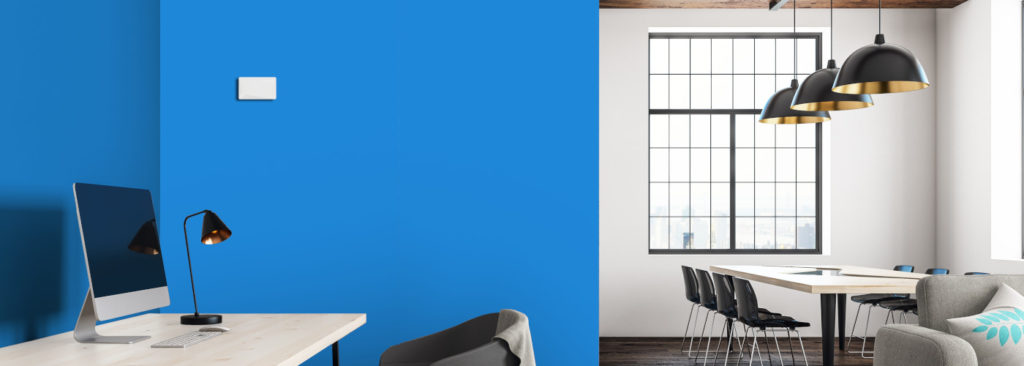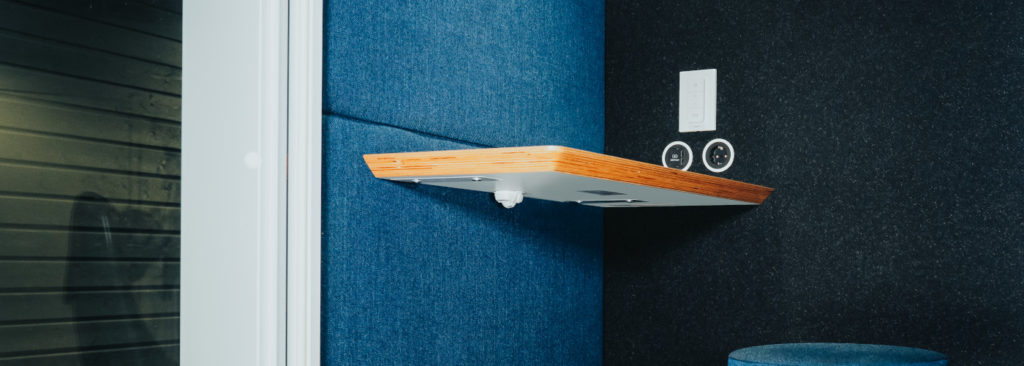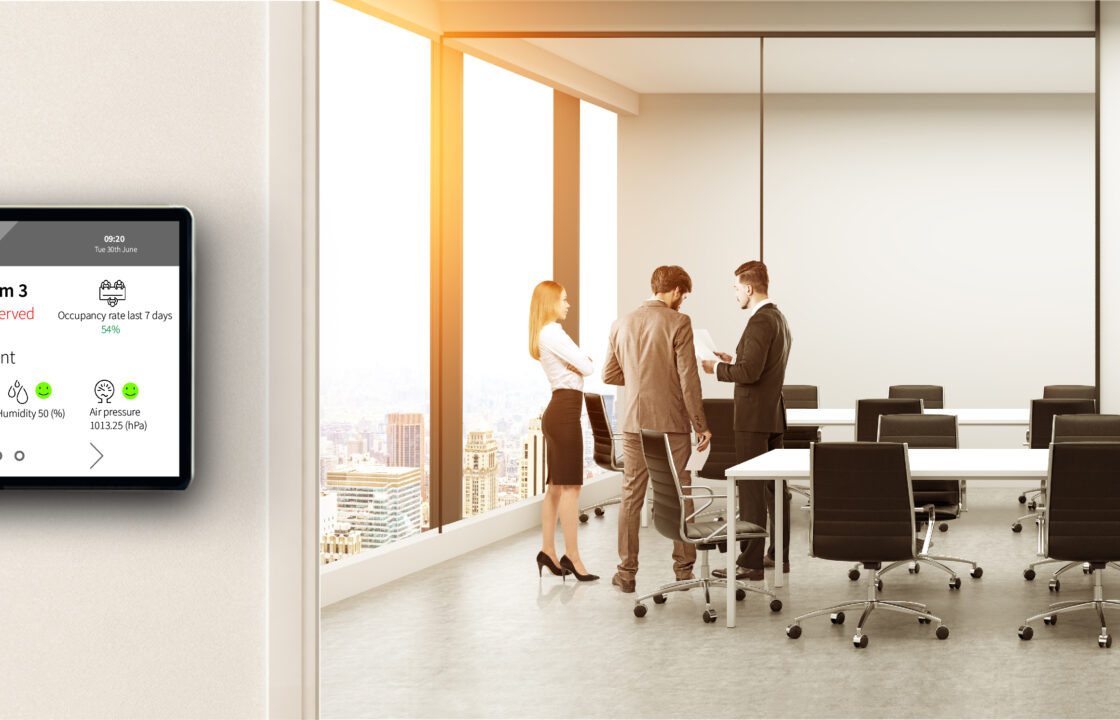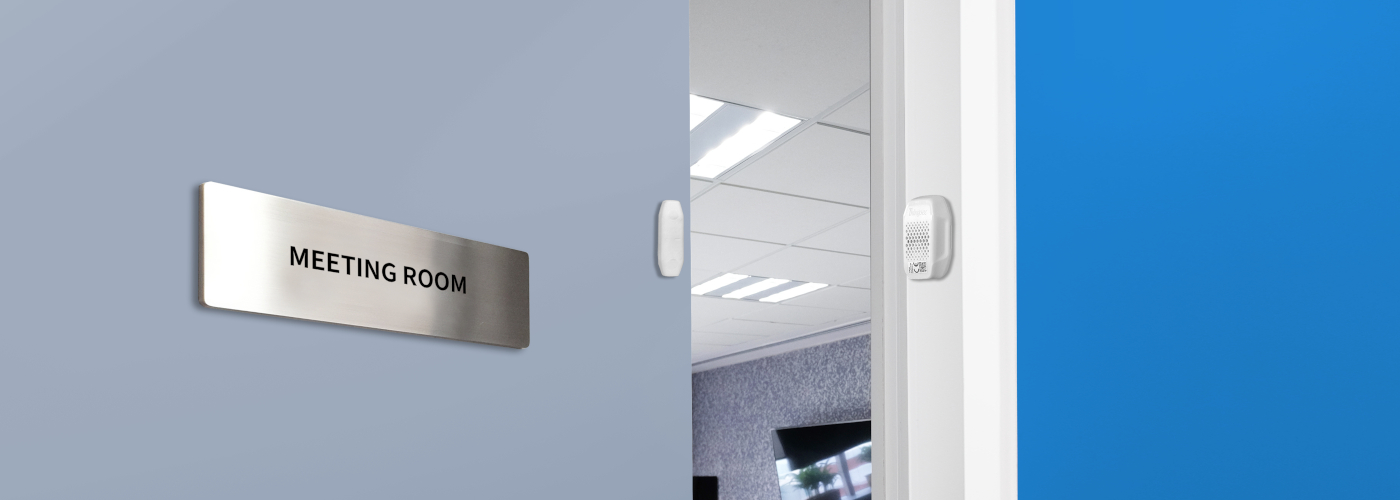While real estate is expensive, at the same time it’s one of the expenses a company can reduce quite easily. Optimizing your office space usage can help you reduce costs, but it also comes with the great benefit of improving the working environment.
To optimize space usage, it is essential to know how your spaces are currently used. In this, office sensors can help. Using office sensors to gather data will help you make educated decisions, change your ways of working and in the end, boost your office’s performance.
Using office sensors will also help you ensure a safe return to the office as the pandemic shifts away, as they provide data on the number of people at the office, and enable targeted cleaning strategies and social distancing where needed.

What are office sensors?
Office sensors are an array of sensor devices developed to gather data from the office environment. They are tasked with recognizing even the smallest of changes in their immediate environment and giving insight on things such as air quality, room and desk usage, and people presence. This allows companies to optimize their working environments, visualize free and occupied desks in office software and save on office costs.
Smart office sensors include environmental sensors, light sensors, occupancy monitoring sensors, desk sensors and visitor counting sensors.
Office sensors are usually part of an IoT solution, and the connectivity is usually based on Wi-Fi, Bluetooth, or cellular connectivity. It is important to choose a solution with a suitable connection for your use case, as you want minimal costs and minimal interruptions in your existing networks.
For a more in-depth look at the technologies used in office sensors, read Indre’s article here:
What are the common technologies in IoT devices?
Types of office sensors
Office sensors can be classified into five different categories: Environmental sensors, light sensors, occupancy monitoring sensors, desk and visitor counting sensors.
Environmental sensors
The most common type of office sensor is the so-called environmental sensor. As the name suggests, environmental sensors monitor the environmental conditions of the office. This includes temperature, humidity, lighting, noise, and the indoor air quality of the office. Environmental data helps with workplace management, ensuring that the office is properly maintained for the best experience for your employees.
Environmental sensors monitor changes in temperature in their vicinity. Environmental sensors that are capable of temperature monitoring and are connected to an HVAC system or a central thermostat can act if the temperature goes above or below a certain temperature threshold.
Humidity is measured by the water content in the air by the environmental sensors and they are determined to activate if the levels of humidity cross a certain threshold. Similarly, to temperature monitoring, humidity monitoring is usually connected to an HVAC system or a dehumidification system.
Indoor air quality is measured by monitoring the levels of certain pollutants, such as CO2, PM2.5 and TVOCs. Usually, indoor air quality monitoring also takes into consideration the temperature and humidity of the area. Having good air quality in your office improves not just the employees’ well-being, but their performance as well.
Noise sensors are used to determine the noise levels in an environment. A noise sensor uses a microphone to report on the noise stages and deliver that data in a readable format to the end-user. Having noise sensors in an office environment is important, as they give the tenants real-time insights on where to find the most suitable places for different work tasks. They can seek a place for some quiet working time or a place to have conversations with their colleagues.
Light sensors
Light sensors are devices that detect the amount of visible light from a surrounding or a light source. In this context, the measurement of light sensor output is lux. It is the term used to measure illuminance, in other words, the area where the luminous flux is spread.
Light sensors have their use cases in monitoring the brightness of an area in an office, for example. This has a use case for both the building tenant and the building owner. The tenant can seek the most suitable working environment for their working needs, and the building owner can gather data on how the lighting affects the space usage.
Occupancy sensors
Occupancy monitoring sensors are desk or room sensors that can be placed in, e.g., meeting rooms, phone booths or any other space at your workplace where you wish to measure utilization and follow occupancy levels.
Occupancy monitoring sensors provide you data to further understand your spaces are used so that the usage can be optimised without sacrificing employee experience.
Occupancy sensors are usually based on a Passive InfraRed sensor (PIR) that detects motion by receiving infrared radiation. PIR sensor device technology is not based on a camera, which means that they detect movement completely anonymously.
There are a variety of smart office occupancy sensors out there that monitor utilization and occupancy, so knowing what features to look for is important when you’re getting started, read more from our article on workplace utilization and occupancy sensors:
Workplace utilization & occupancy monitoring sensors – how to get started?
Desk sensors
Desk sensors are a subset of occupancy monitoring sensors and are used to monitor the desk occupancy in your office. There are a few types of office desk sensors, of which the most used desk sensors are based on passive infrared technology (PIR). There are desk mounted sensors, ceiling mounted sensors and then solutions which require employees to carry a tag to monitor occupancy.
Here are the different types of desk sensors and how they work:
PIR sensors
PIR, or passive infrared sensors, are small, under-desk mounted sensors, aimed to monitor the usage and occupancy of the desk. Like other motion detection equipment, PIR desk sensors are triggered by motion and movement.
The working logic is quite simple. When there is no change in heat or movement detected by the sensor, the status is set to zero, for example. This can then be shown in the user-end application as a vacant table. When the sensor detects motion or heat, the status changes to one, meaning that the desk is now in use by someone.
PIR sensor data cannot be used to identify the person using the desk with the sensor in it, as it is based on heat and movement, and therefore does not record any photos or video of the person sitting at the desk. This means that these office occupancy sensors are GDPR compliant and protect the user’s anonymity.
PIR sensors are also relatively cheap and easy to install. In a best-case scenario, the installation is done in a few seconds, which means taking them into use even in a larger office is easy.

Thermal sensors
Thermal sensors are ceiling-mounted sensors that detect body heat in the area and then use computer algorithms to determine the number of people in a specified space. These sensors together create a grid of the monitored area and visualize the occupancy in a heatmap-style image.
The benefit of using a thermal sensor is that a single thermal sensor can cover a larger area than a single PIR sensor can. Thermal sensors are also as private as PIR sensors, so people cannot be identified in any way.
However, thermal sensors do have some downsides too. First, they are very expensive, especially in comparison to the PIR sensors. Whereas PIR sensors can cost around 50$ in the best case, the cost of thermal sensors can vary from hundreds of dollars to over a thousand dollars apiece.
Second, thermal sensors have a range of 5-10 meters of space each, which means that you need to get a lot of sensors at a high cost per unit. This is a big consideration, especially if you have a large office you’d like to monitor.
UWB and RFID -based systems
Ultra-wideband (UWB) or RFID sensors and tags are another way to track occupancy in your office. They require the users to carry a small transmitter, known as a tag, which can be, for example, integrated into the employees’ badge.
UWB and RFID both work similarly: receivers are deployed in the space, which together with the transmitters do a triangulation of the location of the tag. UWB is the newer technology of these two and is, therefore, more accurate than RFID.
UWB and RFID-based monitoring differ from the PIR and thermal sensors as it is not passive and shifts the responsibility of occupancy monitoring to the employees carrying the transmitters.
Like the thermal sensors the general range of these systems is not large (5-10m), and therefore you need a lot of receivers to cover your office space. Due to the lack of choices in the market, this kind of occupancy monitoring can get expensive fast.
Visitor counting
Visitor counting sensors, or people counters, are sensors usually installed at the entrances or other key points, monitoring the number of people passing through. They help in getting data on how the space is used and when the traffic reaches its highest and lowest points. Good visitor counting sensors do this without collecting any personal information and are thus GDPR-compliant.
There are a few methods by which these people counters collect data: thermal, video, break-beam or time-of-flight and Wi-Fi or Bluetooth-based methods are all used. Thermal sensors work by detecting body heat as visitors go past the sensor and video-based solutions capture foot traffic by visual detection.
Break-beam-based sensors detect the motion of the visitors by sending a beam of light and registering each time the beam is crossed. Wi-Fi or Bluetooth-based sensors on the other hand rely on connecting with the visitors’ mobile devices and calculating foot traffic from there.
No matter the technology used, the benefits of visitor counting sensors are great: they help you understand your office usage better by monitoring traffic amounts and the flow of foot traffic. This allows you to make data-driven decisions on how to optimise your space usage.
Practical applications of office sensors
So, what can you use office sensors for? Let’s look at a few practical applications on how to use office sensors to boost your office.
Office sensors have a great number of practical applications, all aimed to improve your working space:
- Gaining data on space utilization and thus repurposing the spaces
- Allowing for co-working strategy adoption, including hybrid work, hot-desking and sharing the unused spaces between employees.
- Controlling operational costs for lighting and HVAC systems by using office sensors to determine when spaces are used, allowing for an automated thermostat or lighting changes.
- Automating check-in for office and conference room reservations, when integrated with reservation and booking applications.
- Data-driven cleaning support, by offering real-time occupancy data on spaces that have just been used and thus require cleaning.
- Monitoring operational capacity limits, allowing for automated messages to alert key individuals when spaces are nearing the allowed capacity. This is especially handy during a pandemic or a similar situation when operating at a reduced capacity.
Read how to get started with workplace utilization and occupancy sensors!
Considering all those use cases, office sensors are a great way to improve your workplace. There are other benefits as well:
Benefits of using office sensors
When using office sensors in a practical context, they offer benefits that no other solution can give you. First, office sensors give you the benefit of making data-driven design decisions in your office space. The gathered occupancy data helps you optimize your spaces in a way that fits your employees’ needs.
Using office sensors also enables you to be flexible with your space office management, as you can see what spaces need which kind of changes to be more user-friendly and better utilized. This boosts your office to be a better place for your employees.
Office sensors also allow you to be nimble in scaling up your office space as well, as they provide facts on how much expansion in desks or square footage is needed to accommodate your business growth.
Environmentally speaking, office sensors ensure that the workplace is well-ventilated to support your employee’s health. They also help you reduce the carbon footprint of the office by allocating energy resources for the actual and factual demand.
Office sensors offer you instant visibility of your occupancy rates. The data includes the available capacity at any given moment, the meeting room utilization rates and average desk occupancy rates. Office sensors also help you learn about your peak utilisation times and dates, allowing for better management of your workforce. On top of that, you know how environmental factors such as temperature and noise affect the usage of spaces in the office.
Lastly, controlling your office spaces with office sensors and connected systems allows for a more sustainable future. Knowing which spaces are in use and require cleaning or air-conditioning is key when being as sustainable as possible with your resources.
Does your workplace need office sensors?
For companies that are looking to shift into flexible working styles or are eager to get data to challenge their current initiatives, office sensors will quickly become essential. Understanding how sensors work and what they can be used for is needed to shift into these working models.
The data these sensors provide make it possible to learn about your building and your employees’ behaviour, so you can provide the best possible office experience for them.
If you are making these changes in your company, then you are at the right place. We at Haltian are experts in creating easy-to-install solutions for your offices, take a further look at our offering here:

Download our sensor catalog!
Learn how to improve the efficiency of your business with Haltian IoT building devices.
